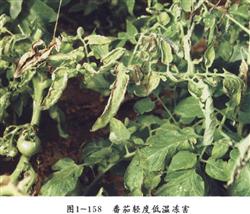Management techniques of Tomato after Frost injury in greenhouse

The cultivation of tomato in greenhouse often leads to different degrees of freezing injury due to abnormal weather changes. In those who were lightly frozen, the growth stagnated and the plants yellowed. After individual restoration of growth, the plants were short, the leaves were small, the nodes were short, the flower topping appeared, the yield was low and the quality decreased. If the frozen person is not remedied in time, he will not be able to resume growth and die. The crops suffering from freezing injury in the greenhouse can take the following remedial measures: 1. Irrigation to alleviate and cool down. Timely irrigation of tomato in greenhouse after freezing can increase the heat capacity of greenhouse soil, prevent the soil temperature from continuing to decline, stabilize the surface air temperature after irrigation, stabilize the air temperature, and restore the normal growth of frozen tissue fluid. 2. Keep the wind and cool down. After the tomato in the greenhouse is frozen, do not close the greenhouse to raise temperature immediately, but let the air cool down, make the temperature in the greenhouse rise slowly, and give the frozen tissue sufficient time to absorb the water removed by the freeze, so as to promote the revival of the frozen tissue and reduce the death of the tissue. 3. Artificial water spraying. Spray water with a sprayer in the greenhouse to increase the air humidity in the greenhouse, so as to stabilize the greenhouse temperature, inhibit the dehydration of frozen tissue, and promote the absorption of frozen tissue. 4. Shading from the sun. Build a sunshade on the shed to prevent direct sunlight, dehydrating and shrinking the tomato tissue and losing its vitality. 5. Topdressing and spraying. After the slow seedling of the frozen tomato, the quick-acting fertilizer should be applied in time to cut off the dead tissue so as to make the tomato grow rapidly. At the same time, it is also necessary to strengthen management and timely use of drugs to control diseases and insect pests.
- Prev

How to store tomatoes in winter
The key to tomato storage in winter is heat preservation. The tomato used for winter storage is the green ripe fruit harvested from the plastic greenhouse cultivated after autumn. The green ripening tomato is most afraid of low temperature. If the tomato is stored below 8 ℃ for a long time, the fruit will suffer frost damage, the surface will appear watery spot sinking, browning, and the fruit pedicel will become light brown.
- Next

There are some methods for the management of tomato after planting in spring.
1. Ploughing should be done in time after planting. Early ploughing and deep ploughing are beneficial to the increase of soil temperature and promote rapid rooting and slow seedling growth. It is more important for early-maturing cultivation. The middle ploughing should be carried out for 4 times in a row, and the depth is shallower each time. Promote the growth of adventitious roots at the base of the stem and expand the root group. 2. Fertilizer and water management Xihong.
Related
- Where is it suitable to grow horseradish in China? it is expected to see the middle altitude horseradish in Alishan.
- How to prevent tomato virus disease reasonably? (Control methods included)
- Many people like to plant towel gourd on the balcony. What are the main points of this method and management?
- What crops can chili peppers be mixed with?
- Fertilization techniques and matters needing attention in Tomato
- What are the grafting techniques for peach seedlings in spring?
- Harm and control methods of root swelling disease of Chinese cabbage
- What are the pests of sweet potatoes? How to prevent and cure it?
- Symptoms, causes and Control methods of navel Rot in Tomato
- The cause of "Cucumber rotten bibcock" in Farmers' planting Cucumber and its Control Plan

